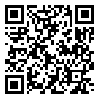Volume 30, Issue 4 (2024)
AIJH 2024, 30(4): 133-159 |
Back to browse issues page
Download citation:
BibTeX | RIS | EndNote | Medlars | ProCite | Reference Manager | RefWorks
Send citation to:



BibTeX | RIS | EndNote | Medlars | ProCite | Reference Manager | RefWorks
Send citation to:
Azimi K. Virtual Literature Problems: Features, Elements and Literary Genres. AIJH 2024; 30 (4) :133-159
URL: http://aijh.modares.ac.ir/article-31-59109-en.html
URL: http://aijh.modares.ac.ir/article-31-59109-en.html
Assistant Professor, Department of Arabic Language and Literature, Khorramabad Branch, Islamic Azad University, Khorramabad, Iran. , kazimy57@gmail.com
Abstract: (258 Views)
In recent years, the publication of literary works in digital space and virtual networks - which we named as virtual literature - is increasing and expanding. This type of literature takes on a new color every day with the invention of new communication, information and multimedia technologies and therefore has special features. Due to the change in the context and method in virtual space, literary works are presented in terms of features, elements and literary genres, different from written and traditional literature. This article seeks to use the argumentative method after describing the facts in the virtual literature paradigm to provide the necessary reasons for measuring this hypothesis based on scientific theories: "Virtual literature as a new theory in the digital age." It has characteristics, elements and genres that distinguish it from written and traditional literature." The results of this research indicate that in virtual literature, virtual poetry or hyper poetry and in prose, hypertext fiction are used more than other types of literature and have a prominent place in multimedia literary productions.
Keywords: Cyberspace, Virtual Literature, Literary Genres, Virtual Poetry, Hypertext Fiction, Contemporary Persian Literature
Article Type: Original Research |
Subject:
Arts and Humanities (General)
Received: 2022/01/29 | Accepted: 2022/09/14 | Published: 2024/06/17
Received: 2022/01/29 | Accepted: 2022/09/14 | Published: 2024/06/17
Send email to the article author
| Rights and permissions | |
 |
This work is licensed under a Creative Commons Attribution-NonCommercial 4.0 International License. |






